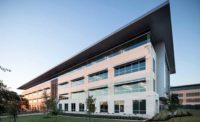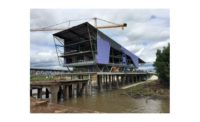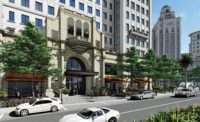Economic crises, lawsuits and other complications have thrown multiple wrenches into plans for downtown Miami’s massive Worldcenter mixed-use project over the past 12 years. But to hear the master development group’s managing principal Nitin Motwani tell it, the timing for the $2-billion “city within a city” to finally come to fruition couldn’t be better.
Motwani, who with founding principal Art Falcone leads Miami Worldcenter Associates, points to all the new structures that have been built in the downtown area since the development group began acquiring more than 100 parcels for the 27-acre development: the Frost Museum, the Adrienne Arsht Performing Arts Center, the American Airlines Arena and Brightline’s new Miami Central rail station, all within walking distance of Worldcenter.
“Miami has become a gateway city,” Motwani says.
To illustrate his point, Motwani points to the development’s $250-million, 60-story Paramount condominium tower, on track for completion early next year on the heels of another major first phase component, the $300-million, 444-unit Caoba apartment tower. Buyers for Paramount’s nearly 570 units represent more than 50 countries, Motwani says. “Not many cities have something like that.”
But though the protracted process to fine-tune Worldcenter’s vision and secure the necessary approvals may have been unavoidable and, ultimately, worthwhile, Motwani and his partners wasted little time in turning those plans into reality. In early 2016, the construction joint venture of Miami-based Coastal Construction and New York-based Tishman Construction broke ground on the two high-rises as well as a 1,100-space parking structure and the initial 140,000 sq ft of the development’s open-air retail component.
Coastal/Tishman also handled approximately $100 million worth of infrastructure improvements, including water, sewer, drainage, road reconstruction, hardscape, landscaping and irrigation.
Tom C. Murphy, Coastal Construction co-president, readily admits that such an intense, multifaceted building program presented a major coordination challenge, especially as the projects have separate development collaborators and design teams. Cohen Freedman Encinosa & Associates of Miami Lakes designed Caoba, while Elkus Manfredi Architects Ltd of Boston designed the Paramount condominium tower and provided master planning for the entire Worldcenter development.
But there are advantages to this approach as well, Murphy adds.
“We have a single project executive in charge who is able to manage everything at the same time, and in the same place,” he explains. “We can take advantage of efficiencies that might not be possible otherwise.”
One positive is the mass buying power that, so far, has helped Worldcenter stay ahead of rising materials costs. The development team has also managed to secure sufficient construction labor while also using job fairs and community outreach efforts to help fulfill a preconstruction pledge to aggressively recruit both skilled and unskilled workers for Miami’s economically depressed areas, including the nearby Overtown neighborhood.
According to Miami Worldcenter Associates, 75% of the project’s more than 1,000 daily workers reside in Miami-Dade County. A training/apprentice program has also produced 200 hires to date.
Despite facing some unresolved building design issues as construction got underway, Kevin Davis, Coastal/Tishman project executive, reports that progress overall on Worldcenter has been good following site preparations that included building demolitions, utility relocations and a permanent street closure.
“A master phasing plan coordinated all water, sewer, fire services [and] hardscapes, to sequence these installations around the planned temporary occupancy certificate dates for each project,” Davis says, adding that the work schedule also had to consider the event calendars at the arena and Bayfront Park so that several surface parking lots could remain open when needed.
Technical Refinements
One issue for the Paramount condominium involved the exact configuration and structural steel requirements for a structural belt truss, or ring beam, that would provide lateral stability for the 696.5-ft-tall, 1.78-million-sq-ft structure. Located at levels 47-48, the belt truss consists of 289 tons of steel and 598 cu yd of concrete, and required seven weeks to construct.
The Paramount’s original curtain wall exterior design also underwent a last-minute revision, being replaced with a window wall system with glass slab edge covers. Murphy says the revised approach, which totals approximately 850,000 sq ft of glazing, achieves the design’s original exterior effect at less cost.
“It’s an idea we may use for other projects,” he says.
Next door, a seven-story post-tensioned concrete garage built on spread footings features a roof that doubles as the Paramount’s amenity deck, with three swimming pools, 26 bungalows, water features and landscaping. The garage is also being prepared for more than 57,000 sq ft of future retail fit-out.
Fewer issues have been encountered with the 445-ft-tall, 43-story stucco-clad Caoba apartment building, built on a foundation podium supported by 480 auger-cast piles ranging up to 120 ft deep. The 10-story podium, which incorporates an 888-space garage, is designed to accommodate the future addition of a 40-story tower. A concrete crown structure will conceal all rooftop MEP equipment.
In addition to retail at the base of the Caoba and Paramount towers, Worldcenter’s Seventh Street Promenade, which runs the length of the development, will be home to an urban retail and dining district, a component of the development-wide open-air retail program adopted when a planned enclosed shopping mall was dropped from the project. Originally planned as a single project, Davis says the district will be built in two phases by separate capital partners.
Perhaps the biggest challenge faced by the Coastal/Tishman team since construction began was Hurricane Irma, which forced an eight-day shutdown as it passed to the west of Miami in September 2017. In preparation for the storm, tower cranes were lowered and all loose materials secured or removed from the site prior to the storm.
Motwani credits both the construction team’s efforts and Worldcenter’s relatively high location 12-16 ft above Miami’s water table for preventing any flooding across the site, which he says should calm those concerned about the city’s looming vulnerability to climate change.
“It is true we have to consider things that weren’t talked about or mentioned 10 years ago,” he says. Yet with voters having recently endorsed the Miami Forever bond package that dedicates $200 million toward flood prevention and sea-level-rise mitigation projects, “people recognize the problem and are willing to do something about it,” he adds.
More To Come
Construction activity at the Worldcenter site is also set to remain hectic for the foreseeable future. Work is set to begin later this year on a 1,700-room Marriott Marquis hotel, which will include 500,000 sq ft of meeting and event space, and on the 434-unit LUMA apartment tower. A mixed-use office tower is also slated to get underway in 2019, along with fit-out of the first retail elements. Contractors have yet to be selected for those projects.
In addition, Netherlands-based citizenM has filed plans for a 12-story, 348-key luxury hotel within the project area. Gensler has been tapped to design the 128,000-sq-ft building.
With Worldcenter arriving at a time when demand for urban living is on the rise across the country, and with autonomous vehicle technology poised to alter the concept of mobility, Motwani is confident that the project will attract interest well into the future. Along with the proximity of Brightline and Miami-Dade’s other public transportation, Worldcenter also sits at the crossroads of the region’s major highways.
To be sure, “there are always surprises anytime you start digging underground,” Motwani says. “But everything is progressing well, and we’re eager to reach the next milestone.”












Post a comment to this article
Report Abusive Comment